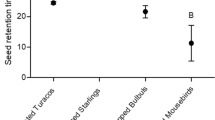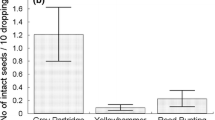Abstract
Avian frugivores play a key role in seed dispersal of many plant species, including invasive alien plants. We assessed the effect of gut passage on the germination of selected invasive alien plant species in South Africa. Fruits of four fleshly-fruited invasive alien plant species: Solanum mauritianum, Cinnamomum camphora, Psidium guajava, and Morus alba, were fed to two species of indigenous turacos, Knysna (Tauraco corythaix) and purple-crested (Gallirex porphyreolophus) turacos, and to invasive rose-ringed parakeets (Psittacula krameri). Seed retention time was determined as this can influence both seed dispersal and germination success. Germination success of ingested seeds was compared with that of manually de-pulped seeds, as well as to seeds in whole fruit. The germination success of seeds of all the invasive plant species increased significantly after ingestion by both turaco species compared with seeds from whole fruits. Germination success of manually de-pulped seeds did not differ significantly from that of turaco ingested seeds. In contrast, seed passage through the digestive tract of rose-ringed parakeets significantly reduced germination success and viability of ingested invasive plant species. Our results suggest that Knysna and purple-crested turacos are legitimate seed dispersers of fleshy-fruited invasive plants, while rose-ringed parakeets are mainly seed predators. Although seed predation by rose-ringed parakeets negatively affects the reproductive success of these plants, it is unlikely that this will suppress the spread of these invasive alien plants in South Africa as they are already well established. Furthermore, they can facilitate dispersal by seed regurgitation and dropping uneaten fruits away from the parent plant. Similar trends could be expected for indigenous seeds that rose-ringed parakeets feed on and therefore these birds remain a negative influence within invaded ecosystems.



Similar content being viewed by others
References
Aslan C (2011) Implications of newly-formed seed-dispersal mutualisms between birds and introduced plants in northern California, USA. Biol Invasions 13:2829–2845
Barnea A, Yom-Tov Y, Friedman J (1991) Does ingestion by birds affect seed germination? Funct Ecol 5:394–402
Bartuszevige A, Gorchov D (2006) Avian seed dispersal of an invasive shrub. Biol Invasions 8:1013–1022
Berens DG, Farwig N, Schaab G, Boehning-Gaese K (2008) Exotic guavas are foci of forest regeneration in Kenyan farmland. Biotropica 40:104–112
Brooke RK (1997) Rose-ringed parakeet. In: Harrison JA, Alan DG, Underhill LG, Herremans M, Tree AJ, Parker V, Brown CJ (eds) The atlas of Southern African birds. Birdlife South Africa, Johannesburg, pp 536–537
Butler CJ (2003) Population biology of the introduced rose-ringed parakeet Psittacula krameri in the UK. PhD thesis, University of Oxford, Oxford
Cain ML, Milligan BG, Strand AE (2000) Long-distance seed dispersal in plant populations. Am J Bot 87:1217–1227
Carrion-Tacuri J, Berjano R, Guerrero G, Figueroa E, Tye A, Castillo JM (2012) Predation on seeds of invasive Lantana camara by Darwin’s finches in the Galapagos Islands. Wilson J Ornithol 124:338–344
Charalambidou I, Santamaria L, Langevoord O (2003) Effect of ingestion by five avian dispersers on the retention time, retrieval and germination of Ruppia maritima seeds. Funct Ecol 17:747–753
Chimera CG, Drake DR (2010) Effects of pulp removal on seed germination of five invasive plants in Hawaii. Plant Prot Q 25:137–140
Combs JK, Reichard SH, Groom MJ, Wilderman DL, Camp PA (2011) Invasive competitor and native seed predators contribute to rarity of the narrow endemic Astragalus sinuatus Piper. Ecol Appl 21:2498–2509
Corlett R (1998) Frugivory and seed dispersal by vertebrates in the Oriental (Indomalayan) Region. Biol Rev 73:413–448
Corlett RT (2005) Interactions between birds, fruit bats and exotic plants in urban Hong Kong, South China. Urban Ecosyst 8:275–283
Czarnecka J, Orłowski G, Karg J (2012) Endozoochorous dispersal of alien and native plants by two palearctic avian frugivores with special emphasis on invasive giant goldenrod Solidago gigantea. Cent Eur J Biol 7:895–901
Daehler CC (2003) Performance comparisons of co-occurring native and alien invasive plants: implications for conservation and restoration. Annu Rev Ecol Evol Syst 34:183–211
David JP, Manakadan R, Ganesh T (2015) Frugivory and seed dispersal by birds and mammals in the coastal tropical dry evergreen forests of southern India: a review. Trop Ecol 56:41–55
D’Avila G, Gomes-Jr A, Canary AC (2010) The role of avian frugivores on germination and potential seed dispersal of the Brazilian pepper Schinus terebinthifolius. Biota Neotrop 10:45–51
Davis M (2011) Do native birds care whether their berries are native or exotic? No. Bioscience 61:501–502
Fedriani JM, Zywiec M, Delibes M (2011) Thieves or mutualists? Pulp feeders enhance endozoochore local recruitment. Ecology 93:575–587
Figueroa J, Castro S (2002) Effects of bird ingestion on seed germination of four woody species of the temperate rainforest of Chiloé island, Chile. J Plant Ecol 160:17–23
Fricke EC, Simon MJ, Reagan KM, Levey DJ, Riffell JA, Carlo TA, Tewksbery JJ (2013) When condition trumps location: seed consumption by fruit-eating birds removes pathogens and predator attractants. Ecol Lett 16:1031–1036
Greenberg C, Smith L, Levey D (2001) Fruit fate, seed germination and growth of an invasive vine—an experimental test of ‘sit and wait’ strategy. Biol Invasions 3:363–372
Guix JC (2007) The role of alien plants in the composition of fruit-eating bird assemblages in Brazilian urban ecosystems. Orsis 22:87–104
Hart LA, Downs CT (2014) Public surveys of rose-ringed parakeets, Psittacula krameri, in the Durban Metropolitan area, South Africa. Afr Zool 49:1–7
Henderson L (2001) Alien weeds and invasive plants. Agricultural Research Council, Cape Town
Janzen DH (1981) Ficus ovalis seed predation by an orange-chinned parakeet (Brotogeris jugularis) in Costa Rica. Auk 98:841–844
Jordaan L, Johnson S, Downs C (2011a) The role of avian frugivores in germination of seeds of fleshy-fruited invasive alien plants. Biol Invasions 13:1917–1930
Jordaan LA, Johnson SD, Downs CT (2011b) Digestion of fruit of invasive alien plants by three southern African avian frugivores. Ibis 153:863–867
Jordaan L, Johnson S, Downs C (2012) Wahlberg’s epauletted fruit bat (Epomophorus wahlbergi) as a potential dispersal agent for fleshy-fruited invasive alien plants: effects of handling behaviour on seed germination. Biol Invasions 14:959–968
Jordano P (1983) Fig-seed predation and dispersal by birds. Biotropica 15:38–41
Koutsos EA, Matson KD, Klasing KC (2001) Nutrition of birds in the order Psittaciformes: a review. J Avian Med Surg 15:257–275
LaFleur N, Rubega M, Parent J (2009) Does frugivory by European starlings (Sturnus vulgaris) facilitate germination in invasive plants? J Torrey Bot Soc 136:332–341
Lambert F (1989) Fig-eating by birds in a Malaysian lowland rain forest. J Trop Ecol 5:401–412
LaRosa AM, Smith CW, Gardner DE (1985) Role of alien and native birds in the dissemination of firetree (Myricafaya Ait.-Myriacaceae) and associated plants in Hawaii. Pac Sci 39:372–378
Lessa LG, Geise L, Costa FN (2013) Effects of gut passage on the germination of seeds ingested by didelphid marsupials in a neotropical savanna. Acta Bot Brasilica 27:519–525
Li X.-H (2004) Avian seed dispersal of the camphor tree (Cinnamomum camphora). Workshop on seed dispersal and frugivory in Asia. China
Mandon-Dalger I, Clergeau P, Tassin J, Riviere JN, Gatti S (2004) Relationships between alien plants and an alien bird species on Reunion Island. J Trop Ecol 20:635–642
Mokotjomela T, Musil C, Esler K (2013a) Do frugivorous birds concentrate their foraging activities on those alien plants with the most abundant and nutritious fruits in the South African Mediterranean-climate region? Plant Ecol 214:49–59
Mokotjomela T, Musil C, Esler K (2013b) Potential seed dispersal distances of native and non-native fleshy fruiting shrubs in the South African Mediterranean climate region. Plant Ecol 214:1127–1137
Mokotjomela TM, Musil CF, Esler KJ (2013c) Frugivorous birds visit fruits of emerging alien shrub species more frequently than those of native shrub species in the South African Mediterranean climate region. S Afr J Bot 86:73–78
Mokotjomela TM, Hoffmann JH, Downs CT (2015) The potential for birds to disperse the seeds of Acacia cyclops, an invasive alien plant in South Africa. Ibis. doi:10.1111/ibi.12260
Murray KG, Russell S, Picone CM, Winnettmurray K, Sherwood W, Kuhlmann ML (1994) Fruitlaxatives and seed passage rates in frugivores consequences for plant reproductive success. Ecology 75:989–994
Nel JL, Richardson DM, Rouget M, Mgidi T, Mdzeke N, Le Maitre DC, Van Wilgen BW, Schonegevel L, Henderson L, Neser S (2004) A proposed classification of invasive alien plant species in South Africa: towards prioritizing species and areas for management action. S Afr J Sci 100:53–64
Olckers T (1999) Biological control of Solanum mauritianum Scopoli (Solanaceae) in South Africa: a review of candidate agents, progress and future prospects. Afr Entomol Mem 1:65–73
Panetta FD (2001) Seedling emergence and seed longevity of the tree weeds Celtis sinensis and Cinnamomum camphora. Weed Res 41:83–95
Paulsen TR, Hogstedt G (2002) Passage through bird guts increases germination rate and seedling growth in Sorbus aucuparia. Funct Ecol 16:608–616
Reid S, Armesto J (2011) Avian gut-passage effects on seed germination of shrubland species in Mediterranean central Chile. J Plant Ecol 212:1–10
Renne IJ, Gauthreaux SA Jr, Gresham CA (2000) Seed dispersal of the Chinese tallow tree (Sapium sebiferum (L.) Roxb.) by birds in coastal South Carolina. Am Midl Nat 144:202–215
Richardson DM, van Wilgen BW (2004) Invasive alien plants in South Africa: How well do we understand the ecological impacts? S Afr J Sci 100:45–52
Samuels IA, Levey DJ (2005) Effects of gut passage on seed germination: Do experiments answer the questions they ask? Funct Ecol 19:365–368
Sinclair I, Ryan P (2003) Birds of Africa south of the Sahara. Struik Publishers, Cape Town
Spotswood EN, Meyer J-Y, Bartolome JW (2012) An invasive tree alters the structure of seed dispersal networks between birds and plants in French Polynesia. J Biogeogr 39:2007–2020
Traveset A (1998) Effect of seed passage through vertebrate frugivores’ guts on germination: a review. Perspect Plant Ecol 1:151–190
Traveset A, Willson MF (1997) Effect of birds and bears on seed germination of fleshy-fruited plants in temperate rainforests of Southeast Alaska. Oikos 80:89–95
Traveset A, Riera N, Mas RE (2001) Passage through bird guts causes interspecific differences in seed germination characteristics. Funct Ecol 15:669–675
van Wilgen BW, Richardson DM, Le Maitre DC, Marais C, Magadlela D (2001) The economic consequences of alien plant invasions: examples of impacts and approaches to sustainable management in South Africa. Environ Dev Sustain J 3:45–168
Vila M, Gimeno I (2003) Seed predation of two alien Opuntia species invading Mediterranean communities. Plant Ecol 167:1–8
Vivian-Smith GE, Gosper CR (2010) Comparative seed and dispersal ecology of three exotic subtropical Asparagus species. Invasive Plant Sci Manag 3:93–103
Wenny DG (2001) Advantages of seed dispersal: a re-evaluation of directed dispersal. Evol Ecol Res 3:51–74
Westcott DA, Fletcher CS (2011) Biological invasions and the study of vertebrate dispersal of plants: opportunities and integration. Acta Oecol 37:650–656
Westerman PR, Liebman M, Heggenstaller AH, Forcella F (2006) Integrating measurements of seed availability and removal to estimate weed seed losses due to predation. Weed Sci 54:566–574
Wilson AL, Downs CT (2011) The effect of seed packaging on digestion and food preference by Purple-crested (Gallirex porphyreolophus) and Knysna (Tauraco corythaix) Turacos. J Ornithol 152:193–200
Wilson AL, Downs CT (2012) Knysna turacos (Tauraco corythaix) do not improve seed germination of ingested fruit of some indigenous South African tree species. S Afr J Bot 78:55–62
Witkowski ETF, Garner RD (2008) Seed production, seed bank dynamics, resprouting and long-term response to clearing of the alien invasive Solanum mauritianum in a temperate to subtropical riparian ecosystem. S Afr J Bot 74:476–484
Yagihashi T, Hayashida M, Miyamoto T (1999) Effects of bird ingestion on seed germination of two Prunus species with different fruit-ripening seasons. Ecol Res 14:71–76
Acknowledgments
Special thanks to the National Research Foundation (NRF) for financial support to A-L. Wilson and V. Thabethe. We are grateful to M. Khambule for his valuable advice and support. Thanks are also extended to M. Zungu for assistance with data analyses and proofreading. T. Mjara is thanked for assisting with data collection. Ethics clearance was obtained from the University of KwaZulu-Natal. We are grateful for the constructive comments of the reviewers.
Author information
Authors and Affiliations
Corresponding author
Rights and permissions
About this article
Cite this article
Thabethe, V., Wilson, AL., Hart, L.A. et al. Ingestion by an invasive parakeet species reduces germination success of invasive alien plants relative to ingestion by indigenous turaco species in South Africa. Biol Invasions 17, 3029–3039 (2015). https://doi.org/10.1007/s10530-015-0932-1
Received:
Accepted:
Published:
Issue Date:
DOI: https://doi.org/10.1007/s10530-015-0932-1




